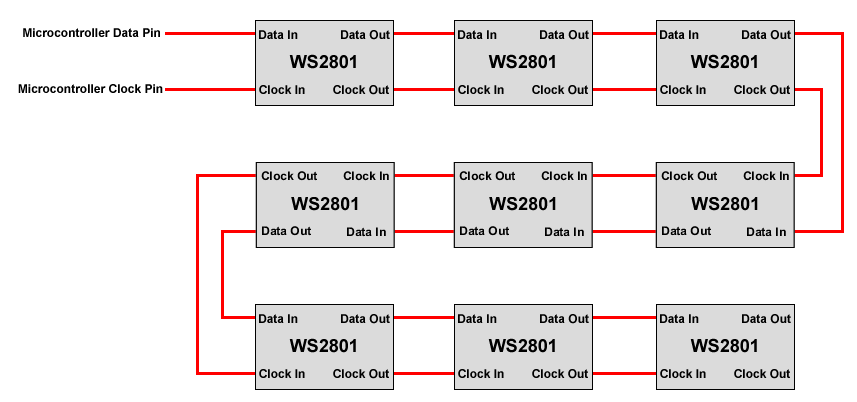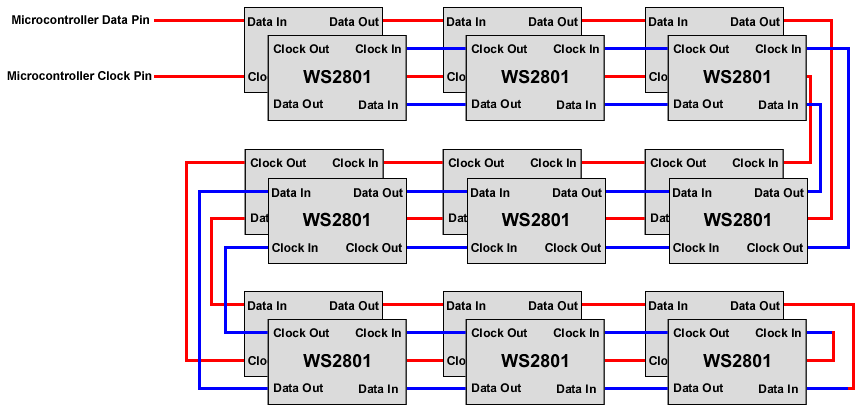Difference between revisions of "Component: RGB LED WS2801 (LEDs)"
(Created page with "{| style="width:50%" |- | width="20%" style="color:gray;" | Author | Matrix TSL |- | width="20%" style="color:gray;" | Version | 2.0 |- | width="20%" style="color:gray...") |
|||
| Line 15: | Line 15: | ||
A simple chained RGB LED controller IC allowing multiple LEDs to be controlled using a serial data stream. Allows RGB LEDs to be driven with full 24-bit colour depth. Allows single chains, 2D arrays and 3D cube formations to be simulated. Supports Bit Banged or SPI peripheral based data modes. | A simple chained RGB LED controller IC allowing multiple LEDs to be controlled using a serial data stream. Allows RGB LEDs to be driven with full 24-bit colour depth. Allows single chains, 2D arrays and 3D cube formations to be simulated. Supports Bit Banged or SPI peripheral based data modes. | ||
| − | ==Component | + | ==Component Source Code== |
| − | + | Please click here for the component source code: [https://www.flowcode.co.uk/wikicopy/componentsource/FC_Comp_Source_LED_WS2801.fcfx FC_Comp_Source_LED_WS2801.fcfx] | |
==Detailed description== | ==Detailed description== | ||
| + | |||
| + | |||
| Line 52: | Line 54: | ||
==Examples== | ==Examples== | ||
| + | |||
| + | |||
| Line 587: | Line 591: | ||
| width="10%" align="center" style="background-color:#D8C9D8;" | [[File:Fc9-prop-icon.png]] | | width="10%" align="center" style="background-color:#D8C9D8;" | [[File:Fc9-prop-icon.png]] | ||
| width="90%" style="background-color:#D8C9D8; color:#4B008D;" | '''Properties''' | | width="90%" style="background-color:#D8C9D8; color:#4B008D;" | '''Properties''' | ||
| + | |- | ||
| + | |- | ||
| + | | width="10%" align="center" style="background-color:#EAE1EA;" | [[File:Fc9-conn-icon.png]] | ||
| + | | width="90%" style="background-color:#EAE1EA; color:#4B008D;" | LED Properties | ||
|- | |- | ||
|- | |- | ||
| Line 649: | Line 657: | ||
| colspan="2" | LEDs will likely be arranged in one of two ways. Parallel = Each row of LEDs run from left to right - easier to address but harder to wire. Alternating = Each row of LEDs runs in an alternating direction - harder to address but easier to wire. | | colspan="2" | LEDs will likely be arranged in one of two ways. Parallel = Each row of LEDs run from left to right - easier to address but harder to wire. Alternating = Each row of LEDs runs in an alternating direction - harder to address but easier to wire. | ||
|- | |- | ||
| − | | width="10%" align="center" | [[File:Fc9- | + | | width="10%" align="center" style="background-color:#EAE1EA;" | [[File:Fc9-conn-icon.png]] |
| − | | width="90%" | | + | | width="90%" style="background-color:#EAE1EA; color:#4B008D;" | Connections |
|- | |- | ||
| − | |||
| − | |||
| − | |||
| − | |||
| − | |||
| − | |||
|- | |- | ||
| width="10%" align="center" | [[File:Fc9-type-16-icon.png]] | | width="10%" align="center" | [[File:Fc9-type-16-icon.png]] | ||
| − | | width="90%" | | + | | width="90%" | Output Mode |
|- | |- | ||
| − | | colspan="2" | SPI | + | | colspan="2" | Sets the output mode used to drive the data to the LEDs Bit Banged Mode = Allows Any I/O Pin but may be slower SPI Mode = Fixed SPI Peripheral Pins but may be faster - Note that the SPI MISO pin will not be available for general I/O |
|- | |- | ||
| − | | width="10%" align="center" | [[File:Fc9- | + | | width="10%" align="center" style="background-color:#EAE1EA;" | [[File:Fc9-conn-icon.png]] |
| − | | width="90%" | | + | | width="90%" style="background-color:#EAE1EA; color:#4B008D;" | Connection Properties |
|- | |- | ||
| − | |||
|- | |- | ||
| width="10%" align="center" | [[File:Fc9-type-5-icon.png]] | | width="10%" align="center" | [[File:Fc9-type-5-icon.png]] | ||
| − | | width="90%" | | + | | width="90%" | Data Pin |
|- | |- | ||
| − | | colspan="2" | | + | | colspan="2" | LED Data Pin - Connected to the Data In pin of the first WS8201 IC. |
|- | |- | ||
| width="10%" align="center" | [[File:Fc9-type-5-icon.png]] | | width="10%" align="center" | [[File:Fc9-type-5-icon.png]] | ||
| − | | width="90%" | | + | | width="90%" | Clock Pin |
| − | |||
| − | |||
| − | |||
| − | |||
| − | |||
| − | |||
| − | |||
| − | |||
| − | |||
| − | |||
| − | |||
| − | |||
| − | |||
| − | |||
| − | |||
| − | |||
| − | |||
| − | |||
| − | |||
|- | |- | ||
| + | | colspan="2" | LED Clock Pin - Connected to the Clock In pin of the first WS8201 IC. | ||
|- | |- | ||
| width="10%" align="center" | [[File:Fc9-type-7-icon.png]] | | width="10%" align="center" | [[File:Fc9-type-7-icon.png]] | ||
Revision as of 17:48, 9 November 2022
| Author | Matrix TSL |
| Version | 2.0 |
| Category | LEDs |
Contents
RGB LED WS2801 component
A simple chained RGB LED controller IC allowing multiple LEDs to be controlled using a serial data stream. Allows RGB LEDs to be driven with full 24-bit colour depth. Allows single chains, 2D arrays and 3D cube formations to be simulated. Supports Bit Banged or SPI peripheral based data modes.
Component Source Code
Please click here for the component source code: FC_Comp_Source_LED_WS2801.fcfx
Detailed description
1D Configuration
In the 1D configuration each LED simply follows on from the last in a chain.
2D Configuration
In the 2D configuration each LED follows on from the last in a chain which travels back and forth through the columns a row at a time.
3D Configuration
In the 3D configuration each layer follows the 2D configuration with each layer then following on by mirroring the layer below. First layer connections are shown in Red and second layer connections are shown in Blue.
3V3 Microcontrollers
Note you may have to voltage shift the micro controller control pins to meet the 0.8 * VDD minimum requirement. E.g. if VDD is 5V then the input voltage needs to be at least 4V.
A simple buffer IC could be used to do the voltage shifting.
Examples
RGB Mood Light
A simple example using three potentiometers to set the individual Red, Green and Blue channels of the LED colour.
![]() MoodLight
MoodLight
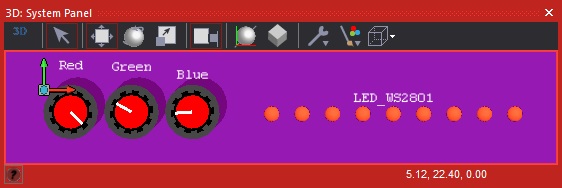
Animated Light
A simple example which picks a random colour assigns it to the first LED, then shifts and repeats.
![]() AnimatedLightStrip
AnimatedLightStrip
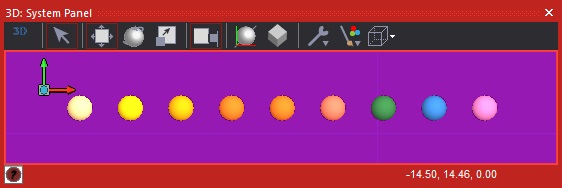
Animated Light Cascade
A simple example which picks a random colour assigns it to the first LED, then shifts and repeats.
![]() AnimatedLightCascade
AnimatedLightCascade
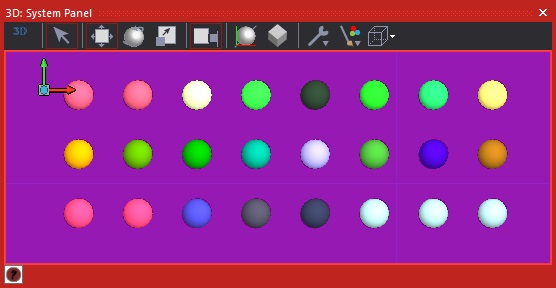
Downloadable macro reference
| GetLEDColour | |
| Sets the colour of a single LED in RAM as a 1D array. | |
| LED | |
| LED to change the colour / Range: 0 to (LED Count - 1) | |
| ColIdx | |
| 0 = R, 1 = G, 2 = B | |
| Return | |
| DrawLine2D | |
| Draws a line on a 2D array of LEDs | |
| X1 | |
| Y1 | |
| X2 | |
| Y2 | |
| R | |
| G | |
| B | |
| Return | |
| SetLEDColour | |
| Sets the colour of a single LED in RAM as a 1D array. | |
| LED | |
| LED to change the colour / Range: 0 to (LED Count - 1) | |
| R | |
| G | |
| B | |
| Return | |
| SetAllLEDColour | |
| Sets the colour of all the LEDs in RAM | |
| R | |
| G | |
| B | |
| Return | |
| Refresh | |
| Clocks out the current colour data to the LEDs from the values stored in RAM | |
| Return | |
| ShiftLEDs1D | |
| Shifts the LED colours in 1D and wraps | |
| Direction | |
| 0 = Forwards, 1 = Backwards | |
| DataMode | |
| 0=ResetToZero, 1=WrapAroundDisplay, 2=Smear | |
| Return | |
| DrawLine3D | |
| Draws a line on a 3D array of LEDs | |
| X1 | |
| Y1 | |
| Z1 | |
| X2 | |
| Y2 | |
| Z2 | |
| R | |
| G | |
| B | |
| Return | |
| Initialise | |
| Inisialises the RGB colour RAM to 0,0,0 = LED Off and clocks out the data to initialise all the WS2801 ICs in the chain. | |
| Return | |

